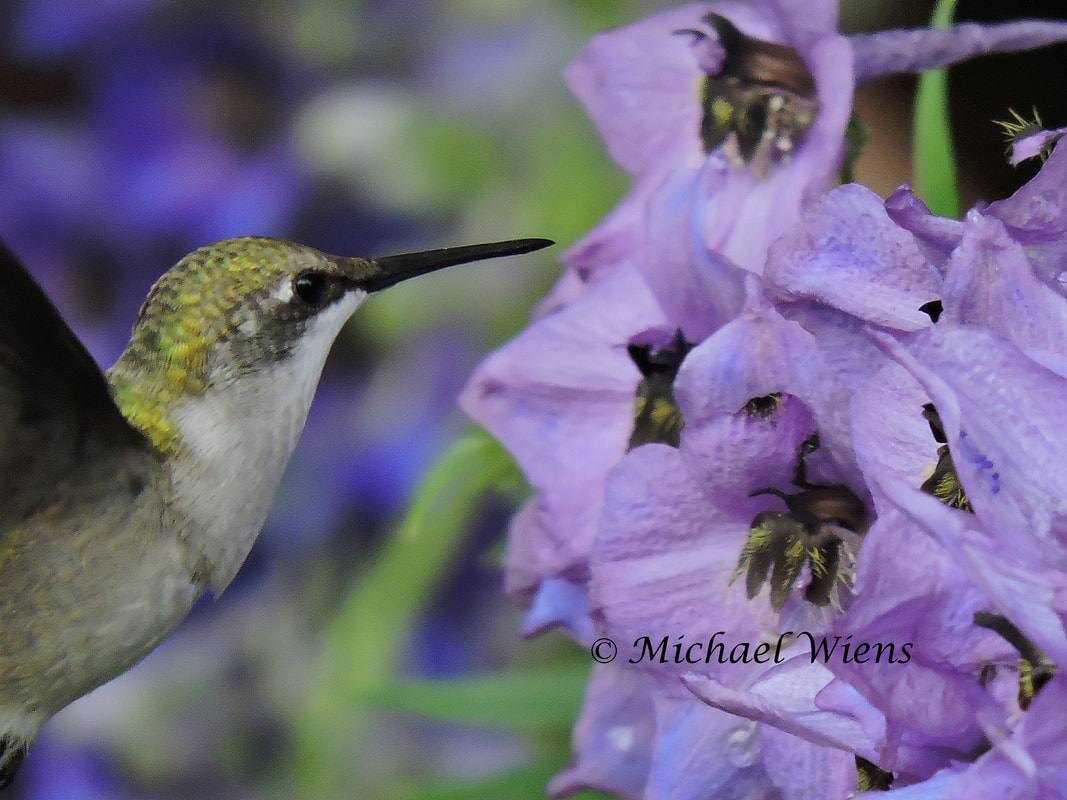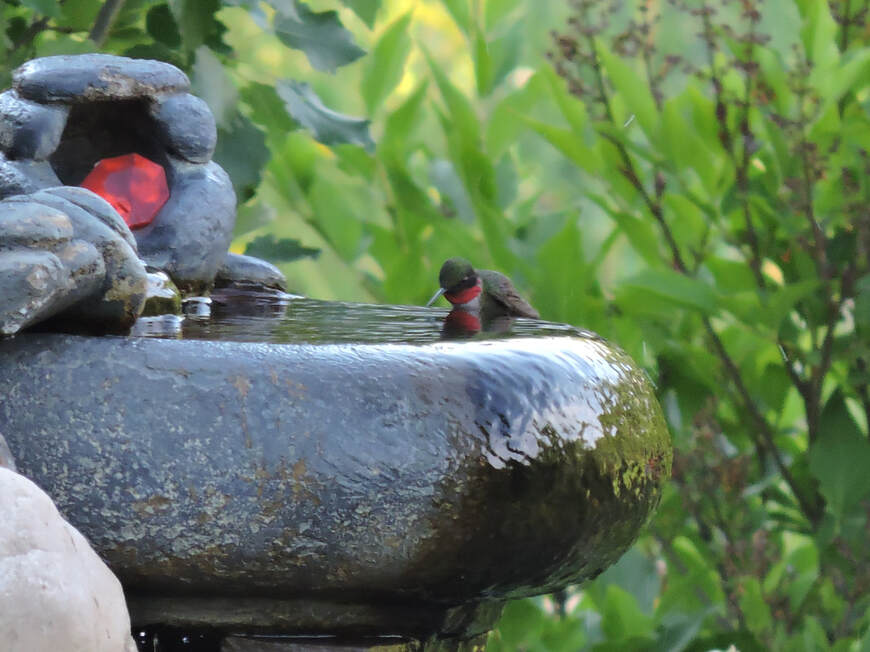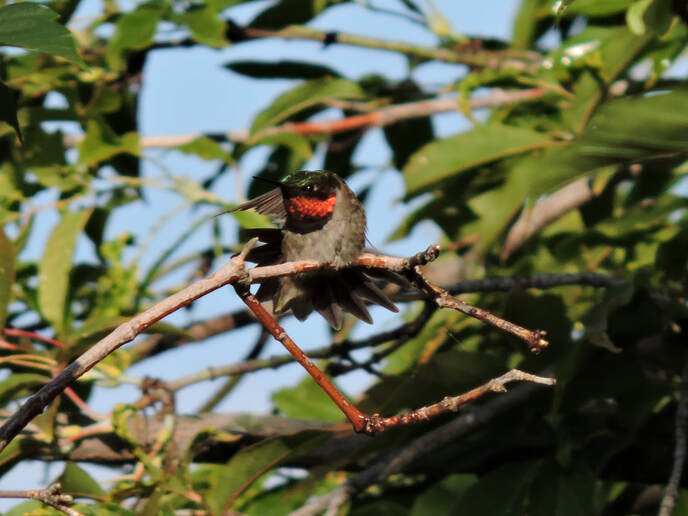Humming Blog |
 From deep within the branches and forests across the continent, little miracles are starting to emerge from what was just the tiniest eggs laid only 45 days ago. Entirely dependent on the mother, they lay defenseless as they wait for her to gather a slurry of insects and nectar to bring back to the nest. She works quietly throughout the gardens, avoiding any threats that could harm her and ultimately her young. As they grow at an enormous speed, they stretch and practice skills that will soon be necessary in a world of dangers. They increase their strength daily, and power up their wings frequently for the soon departure from the nest. At the moment of gathered courage, the two tiny birds leap from dependence into a world so large and colorful. The excitement is uncontrollable as they see flowers and freedom they've only dreamt of. Once again the forests, fields and gardens become alive with the chatter of youth, and the mornings are once again alive with song. First Juvenile Ruby-throat hummingbird of the season. July 29, 2019. N.E. of Edmonton, Alberta, Canada
0 Comments
 This is a topic I've touched on in the past, but wanted to elaborate on it. This is a way you'll learn the habits, behaviors, times, and so much more about your hummingbirds. Eventually the information will become ingrained in your thinking, that you'll not have to refer to past years to know these statistics. What am I talking about? Creating a journal. Create a journal as simple or as complex as you want, but track this information daily. Trust me, you'll find your information valuable from year to year. This will teach you a lot about their behavior, migration, feeding, interaction, and arrival habits. So, what information should we track that's useful. Here's my short list, but if you find certain information useful that I'm missing, then add it to your journal. Date, peak sightings(per minute, hour, or day, (whichever suits your situation)), # of feeders hanging, # of males, # of females, # of Juveniles, weather conditions, and a blank area for any additional information for that day. e.g. rare Rufous, or first young of the season. Also, include that you weren't around on certain days to track. In following years you'll be able to compare one date to another, know how many feeders were suitable for that time of year, how many males, females, or young were sighted and when they peak for the year, what type of weather initiated such a slow or busy day, and other random events that occurred on that specific day. I promise, you will be glad you kept notes, and you will learn an incredible amount when you compare every year on a certain date. Eventually you'll become more aware than you ever were about information extremely valuable in understanding your hummingbirds. The two images are 2 of 3 current males showing up. Ziggy, at the Salvia plant, has the run of everything in the yard, but the other males just can't resist, even though they know they're going to pay the price from Ziggy. From the data collected in previous years, I can expect between 6 and 15 adult males to show up and stick around for a few or several days before heading South. July 20, 2019. N.E. of Edmonton, Alberta, Canada. Adult male Ruby-throat hummingbirds.  For two months Ziggy has had the run of the garden. Every feeder and flower has been available at any given time, but the vacation is just about over. Each day other hummingbirds will become aware of the garden only heard of, where the flowers are endless and the nectar never runs out. It's a garden that hummingbirds dream of, but are limited by the heightened security. With its offerings so abundant, the temptation is too much to overcome. Hummingbirds from all over the region will soon make their way to Ziggy's garden and overwhelm him with their excitement. The numbers of intruders will soon plan an unorganized attack as they arrive from all directions. Males, females and the annoying young will get on his very last nerve. He will no longer be able to defend all corners of his garden, but will retreat to his favorite feeder and closely guard it. This is the continental event soon to take over many gardens worthy of the hummingbirds. The dominant male will soon realize there is too much to defend. He will realize that he is expending far too much energy in chase, and will need to conserve the energy for the migration soon to follow. With little time left to relax, Ziggy, our Male Ruby-throat hummingbird, is taking advantage of the remaining time before the young, other males, and females start to arrive in the garden. Ziggy is soaking up a little "Me Time", as if he doesn't have enough of that already, just before the wave of hummingbirds begins. As vain little Ziggy stares into the water and sees his reflection, he asks himself, "who's the greatest of them all...well, that would be me of course"! N.E. of Edmonton, Alberta, Canada. July 13, 2019. Adult Male Ruby-throat hummingbird  I looked atop every one of his highest perches and he was nowhere to be found. It's usually not difficult to find him sitting on one of the highest branches or even the power pole. I repeatedly turned my head from left to right scanning across the yard for Ziggy. 10 minutes had passed and no sight of him. I checked the bird fountain, perches, and all the feeders, and nothing! As I looked at the feeder to my right, something very tiny caught my eye. There he was 10 feet to my right sitting on a stake we had in the lawn. It seemed a bit humorous as I was scanning left to right across the garden, so was Ziggy. His tiny little head was twitching left to right, also watching over his garden. You seriously start to get attached to these tiny little creatures that look so insignificant in size, but so large in personality and character. As my wife and I were getting into the car and leaving the yard a week ago, Ziggy had to roast by and perch on a dead stick right in front of the car. He seems to have drawn an attachment to us, just like we have to him. We spend hours walking through the garden, weeding and doing much other yard work, and there he sits right above us with little fear and more curiosity. He watches me clean the feeders, and replace with new ones, and always seems to keep a close eye on us. It makes me curious to the depth of his understanding. I try not to personalize their behavior because I know it falls well short of ours, but there is a learning capability within that tiny little brain, and every time I see him do something in relation to one of us it makes me wonder just how much does he really know?  I've frequently talked about the predictability built into the DNA of hummingbirds, which allows us to learn and understand their behavior far more than if they just acted erratic and inconsistent all the time, but there's that special ingredient that's been added to the mix that makes them exciting every time we see them. That's the unpredictability factor. A few variables that we'll never know about have been tossed into the pot, stirred up and added to what we normally think should be. We sat in the yard under a large Maple tree. Ziggy chose to sit 10 feet above us the whole time, with the odd feed mixed in, of course, but then right back to his perch. Some think it's lucky to be pooped on by a hummingbird. They're wrong! The only luck involved is that they're not the size of a Thanksgiving Turkey. He appreciated the shade as did we, but his head twitched constantly as he scouted his territory, his feedings were consistent to the feeders, but then one little thing changed. He got the sudden desire to do something out of normal. From his perch above us he did a pendulum swing, setting his wings so gracefully right down to the Purple Misty Salvia about 75 feet away. He fed from every developed flower and then returned right back to his perch above us. It may sound like a little thing, but it's those little things, those variables that change slightly within their behavior, that we'll never understand. It's those things in all of the wonderful world of nature that makes each moment different and unique. That's what draws us to bird watching. It's the moments where they deviate slightly from the norm and do something that attracts our attention. If every day were completely predictable about their behaviors, our interest would be quickly lost. It's the variables that have been thrown into their DNA that continue to draw us into a world of birding that's so exciting. Ziggy, the male Ruby-throat hummingbird, sits here preening on one of his favorite perches. N.E. of Edmonton, Alberta, Canada. June 14th, 2019. |
Archives
June 2024
Categories
All
|

 RSS Feed
RSS Feed
